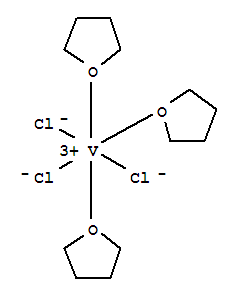Section 1: Product Identification
Chemical Name: Vanadium (III) chloride tetrahydrofuran adduct
CAS Registry Number: 19559-06-9
Formula: VCl3(C4H8O)2-3
EINECS Number: none
Chemical Family: metal halide
Synonym: Vanadium trichloride tetrahydrofuran adduct
Section 2: Composition and Information on Ingredients
Ingredient CAS Number Percent ACGIH (TWA) OSHA (PEL)
Title Compound 19559-06-9 100% no data no data
Section 3: Hazards Identification
Corrosive to skin and eyes. May release toxic and corrosive fumes of hydrogen chloride and aqueous
Emergency Overview:
hydrochloric acid. Tetrahydrofuran can cause drowsiness and unconsciousness.
Primary Routes of Exposure: Ingestion, inhalation, skin, eyes
Eye Contact: Severe corrosive to the eyes. Exposure can lead to permanent eye damage.
Skin Contact: Corrosive to skin. Contact can lead to redness, pain, blistering, ulceration, and scar formation.
Inhalation of tetrahydrofuran vapor may cause coughing, nausea, dizziness, headache, drowsiness, and
Inhalation:
unconsciousness.
Ingestion: Ingestion of tetrahydrofuran or hydrogen chloride may cause gastrointestinal and respiratory irritation.
Inhalation of vapor induces drowsiness and may cause coughing, chest pains, difficulty in breathing, nausea,
Acute Health Affects:
dizziness, headache and unconsciousness. Hydrogen chloride can cause pulmonary edema.
Chronic Health Affects: In animal studies tetrahydrofuran acted as a tumorigen (liver), mutagen and reproductive effector.
NTP: No
IARC: No
OSHA: No
SECTION 4: First Aid Measures
Immediately flush the eyes with copious amounts of water for at least 10-15 minutes. A victim may need
Eye Exposure:
assistance in keeping their eye lids open. Get immediate medical attention.
Wash the affected area with water. Remove contaminated clothes if necessary. Seek medical assistance if
Skin Exposure:
irritation persists.
Remove the victim to fresh air. Closely monitor the victim for signs of respiratory problems, such as difficulty
Inhalation:
in breathing, coughing, wheezing, or pain. In such cases seek immediate medical assistance.
Seek medical attention immediately. Keep the victim calm. Give the victim water (only if conscious). Induce
Ingestion:
vomiting only if directed by medical personnel.
SECTION 5: Fire Fighting Measures
Flash Point: not applicable
Autoignition Temperature: none
Explosion Limits: none
Extinguishing Medium: carbon dioxide, dry powder or foam
If this product is involved in a fire, fire fighters should be equipped with a NIOSH approved positive pressure
Special Fire Fighting Procedures:
self-contained breathing apparatus.
Hazardous Combustion and If involved in a fire this material may emit toxic fumes of hydrogen chloride, carbon monoxide, carbon dioxide,
Decomposion Products: and organic fumes.
Unusual Fire or Explosion Hazards: No unusual fire or explosion hazards.
SECTION 6: Accidental Release Measures
Small spills can be mixed with powdered sodium bicarbonate, lime, or calcium carbonate and swept up. Avoid
Spill and Leak Procedures:
raising dust.
SECTION 7: Handling and Storage
Store solid in a tightly sealed container away from moisture. Handle in a fume hood under a dry atmosphere of
Handling and Storage:
air or nitrogen. Prolonged exposure to the atmosphere may degrade the product.
SECTION 8: Exposure Controls and Personal Protection
Eye Protection: Always wear approved safety glasses when handling a chemical substance in the laboratory.
Skin Protection: Wear protective clothing and gloves. Consult with glove manufacturer to determine the proper type of glove.
Ventilation: The solid may form corrosive vapors. It should be handled in an efficient fume hood.
If in form of fine dust and ventilation is not available a respirator should be worn. The use of respirators
Respirator:
requires a Respirator Protection Program to be in compliance with 29 CFR 1910.134.
Ventilation: The solid may form corrosive vapors. It should be handled in an efficient fume hood.
Additional Protection: No additional protection required.
SECTION 9: Physical and Chemical Properties
Color and Form: red xtl.
Molecular Weight: 157.3
Melting Point: no data
Boiling Point: no data
Vapor Pressure: no data
Specific Gravity: no data
Odor: pungent odor
Solubility in Water: reacts with water
SECTION 10: Stability and Reactivity
Stability: moisture sensitive (store cold)
Hazardous Polymerization: no hazardous polymerization
Conditions to Avoid: contact with moisture
Incompatibility: Water, alcohols, oxidizing agents, oxygen and active metals
Decomposition Products: Vanadium oxychloride, hydrogen chloride, carbon dioxide, carbon monoxide, organic fumes.
SECTION 11: Toxicological Information
RTECS Data: No information available in the RTECS files.
Carcinogenic Effects: no data
Mutagenic Effects: no data
Tetratogenic Effects: no data
SECTION 12: Ecological Information
Ecological Information: No information available
SECTION 13: Disposal Considerations
Disposal: Dispose of according to local, state and federal regulations.
SECTION 14: Transportation
Shipping Name (CFR): Corrosive solids, N.O.S.
Hazard Class (CFR): 8
Additional Hazard Class (CFR): NA
Packaging Group (CFR): II
UN ID Number (CFR): UN# 1759
Shipping Name (IATA): Corrosive solid, N.O.S.
Hazard Class (IATA): 8
Additional Hazard Class (IATA): NA
Packaging Group (IATA): II
UN ID Number (IATA): UN# 1759
SECTION 15: Regulatory Information
TSCA: Not listed in the TSCA inventory.
SARA (Title 313): See category code N770 for reporting.
Second Ingredient: none
SECTION 16 - ADDITIONAL INFORMATION
N/A
